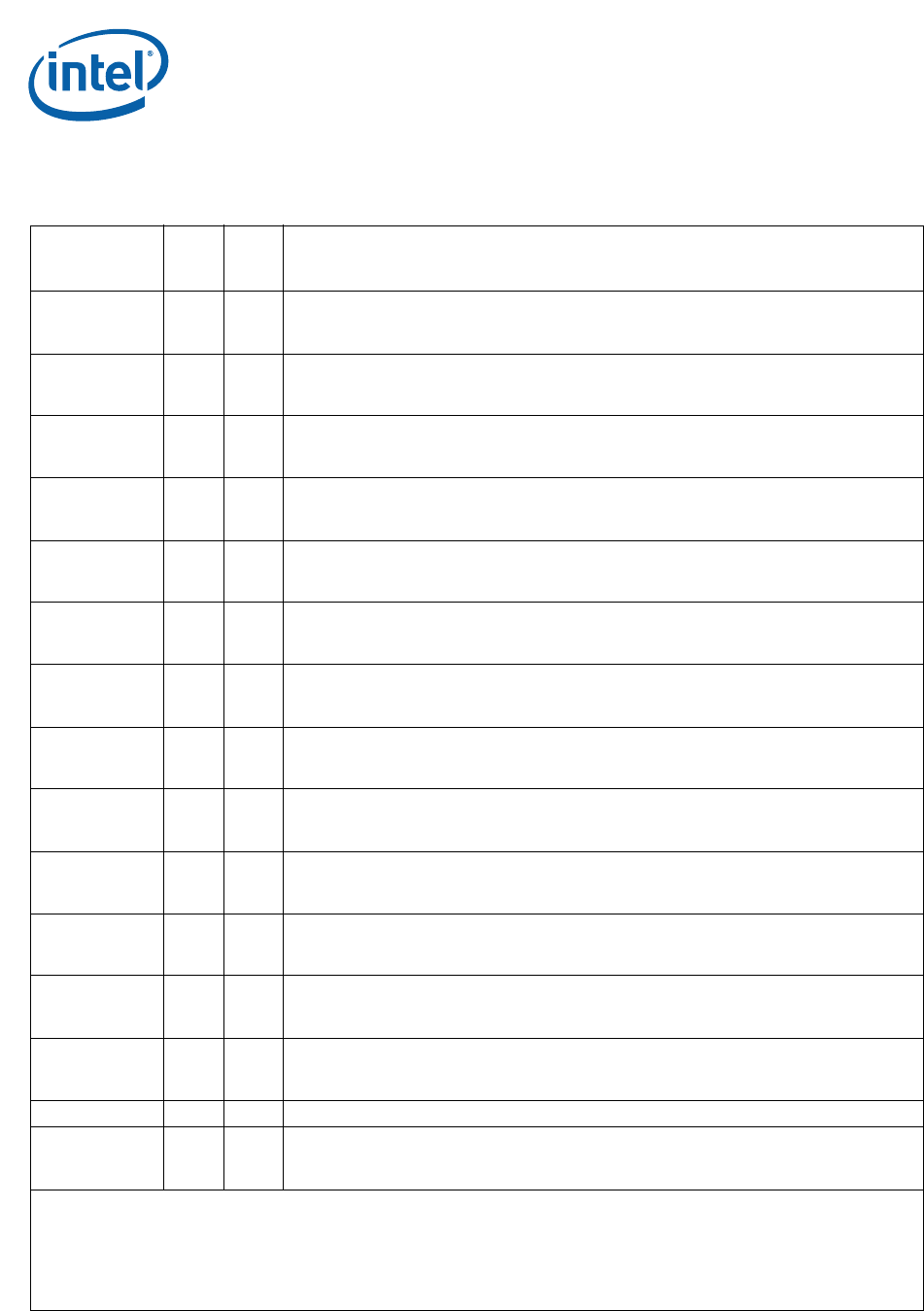
Intel
®
IXP43X Product Line of Network Processors—Hardware Design Guidelines
Intel
®
IXP43X Product Line of Network Processors
HDG April 2007
46 Document Number: 316844; Revision: 001US
3.11.1 Signal Interface
Table 17. PCI Controller (Sheet 1 of 2)
Name
Type
Field
Pull
Up/
Down
Recommendations
PCI_AD[31:0] I/O Yes
PCI Address/Data bus.
When this interface/signal is enabled and is not being used in a system design, the interface/
signal should be pulled high with a 10-KΩ resistor.
PCI_CBE_N[3:0] I/O Yes
PCI Command/Byte Enables.
When this interface/signal is enabled and is not being used in a system design, the interface/
signal should be pulled high with a 10-KΩ resistor.
PCI_PAR I/O Yes
PCI Parity.
When this interface/signal is enabled and is not being used in a system design, the interface/
signal should be pulled high with a 10-KΩ resistor.
PCI_FRAME_N I/O Yes
PCI Cycle Frame.
When this interface/signal is enabled and is being used or not being used in a system design,
the interface/signal should be pulled high with a 10-KΩ resistor.
PCI_TRDY_N I/O Yes
PCI Target Ready.
When this interface/signal is enabled and is being used or not being used in a system design,
the interface/signal should be pulled high with a 10-KΩ resistor.
PCI_IRDY_N I/O Yes
Initiator Ready.
When this interface/signal is enabled and is being used or not being used in a system design,
the interface/signal should be pulled high with a 10-KΩ resistor.
PCI_STOP_N I/O Yes
Stop.
When this interface/signal is enabled and is being used or not being used in a system design,
the interface/signal should be pulled high with a 10-KΩ resistor.
PCI_PERR_N I/O Yes
Parity Error.
When this interface/signal is enabled and is being used or not being used in a system design,
the interface/signal should be pulled high with a 10-KΩ resistor.
PCI_SERR_N I/O Yes
System Error.
When this interface/signal is enabled and is being used or not being used in a system design,
the interface/signal should be pulled high with a 10-KΩ resistor.
PCI_DEVSEL_N I/O Yes
Device Select:
When this interface/signal is enabled and is being used or not being used in a system design,
the interface/signal should be pulled high with a 10-KΩ resistor.
PCI_IDSEL I Yes
Initialization Device Select.
When this interface/signal is enabled and is not being used in a system design, the interface/
signal should be pulled high with a 10-KΩ resistor.
PCI_REQ_N[3:1] I Yes
Arbitration Request.
When this interface/signal is enabled and is not being used in a system design, the interface/
signal should be pulled high with a 10-KΩ resistor.
PCI_REQ_N[0] I/O Yes
Arbitration Request:
When this interface/signal is enabled and is not being used in a system design, the interface/
signal should be pulled high with a 10-KΩ resistor.
PCI_GNT_N[3:1] O No Arbitration Grant.
PCI_GNT_N[0] I/O Yes
Arbitration Grant.
When this interface/signal is enabled and is not being used in a system design, the interface/
signal should be pulled high with a 10-KΩ resistor.
Notes:
1. Features disabled/enabled by Soft Fuse must be done during the boot-up sequence. A feature cannot be enabled after
being disabled without asserting a system reset.
2. Features disabled by a specific part number, do not require pull-ups or pull-downs. Therefore, all pins can be left
unconnected.
3. Features enabled by a specific part number — and required to be Soft Fuse-disabled, as stated in Note 1 — only require
pull-ups or pull-downs in the clock-input signals.


















